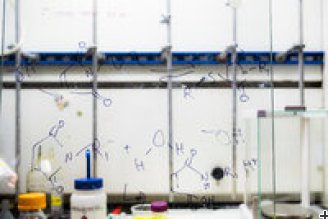Copyright 2012 neutronsources.org | All rights reserved. | Powered by FRM II | Imprint / Privacy Policy
Bundlemers (new polymer units) could transform industries
Date: 30. Oktober 2019
Source: phys.org
From tires to clothes to shampoo, many ubiquitous products are made with polymers, large chain-like molecules made of smaller sub-units, called monomers, bonded together. Now, a team of researchers from the University of Delaware and University of Pennsylvania, with primary support from the U.S. Department of Energy Biomolecular Materials Program, has created a new fundamental unit of polymers that could usher in a new era of materials discovery.
The researchers designed and created rigid, self-assembling, customizable polymer chains by linking together new building blocks called bundlemers – a term coined at UD. They recently described their work in the journal Nature.
To create bundlemers, the team assembles together four individual peptides, themselves short chains of amino acids, into nanoscopic cylinders. The bundlemer cylinders are then linked, together end-to-end through a highly efficient and controlled series of chemical reactions known as ‘click’ chemistry.
“There’s a basic premise in materials that if you can control function and structure, then you can essentially build anything,” said Chris Kloxin, study author and assistant professor of materials science and engineering and chemical and biomolecular engineering at UD. “We have a very well-defined structural unit, this bundlemer, upon which we have the ability to add chemical functionality at any location.”
Because of their rigidity and customizability, bundlemers could be used to design new materials with a wide range of applications, from high-performance fibers to single-use plastics to biologics, medicines that employ biological components instead of traditional chemistries. Biopharmaceutical research and development is a growing area of expertise at the University of Delaware, home to the National Institute of Innovation in Biopharmaceutical Manufacturing (NIIMBL).
Still, despite careful planning, the initial experimental results surprised Pochan and Kloxin — in a good way. When they first saw measurements of the bundlemer chain stiffness, they assumed that something was wrong. Usually polymer chains are loose and flexible like spaghetti, but polymers created from bundlemers are more like long, thin, sturdy rods.
After synthesizing bundlemers, the research team characterized the materials using transmission electron microscopy and cryogenic transmission electron microscopy in the Keck Center for Advanced Microscopy and Microanalysis. They also confirmed the size and structure of the bundlemers through small-angle neutron scattering experiments at the NIST Center for Neutron Research, which has a cooperative agreement with the University of Delaware for the Center for Neutron Science.
Jeff Caplan, confocal microscopy expert and director of BioImaging at the Delaware Biotechnology Institute, performed Stochastic Optical Reconstruction Microscopy (STORM) Imaging to visualize tiny segments within the bundlemers. Caplan is a co-author on the Nature paper.
Next, the team aims to make bundlemers more accessible, easier to synthesize, and scalable.
Scientists around the world could use bundlemers to address a wide variety of grand challenges in engineering. “These are tools for anybody to use, whether you’re a chemist, engineer, or physicist,” said Pochan. “It’s even hard to think of an equivalent material or experimental tool people use widely. It’s like a toolbox for anybody to design future things.”
